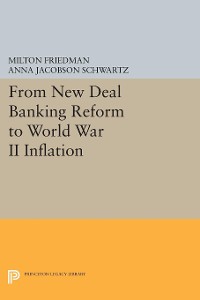From New Deal Banking Reform to World War II Inflation
Anna Jacobson Schwartz, Milton Friedman
Sozialwissenschaften, Recht, Wirtschaft / Wirtschaft
Beschreibung
This selection from the authors' A Monetary History of the United States, 1867-1960 (Princeton) describes the changes that were made in the banking structure and in the monetary standard following the great contraction of 1929 to 1933, the establishment of monetary policies after the New Deal period, and the development of inflation during World War II.
Originally published in 1980.
The Princeton Legacy Library uses the latest print-on-demand technology to again make available previously out-of-print books from the distinguished backlist of Princeton University Press. These editions preserve the original texts of these important books while presenting them in durable paperback and hardcover editions. The goal of the Princeton Legacy Library is to vastly increase access to the rich scholarly heritage found in the thousands of books published by Princeton University Press since its founding in 1905.
Kundenbewertungen
Treasurer of the United States, Recession, Market rate, Tax rate, National Bank Note, Cash, Money supply, Exchange rate, Currency, Discounts and allowances, Bank run, Dollar Shortage, Federal Reserve Deposits, Federal Deposit Insurance Corporation, Government debt, Emergency Banking Act, Federal Reserve Bank, Devaluation, Economic problem, Undistributed profits tax, Federal Open Market Committee, Keynesian economics, Foreign exchange controls, Interest rate, Shrinkage (accounting), Commercial bank, Credit (finance), Milton Friedman, Wholesale price index, Economics, Asset, Excess reserves, Reserve requirement, Supply (economics), Keynesian Revolution, National Industrial Recovery Act, Monetary policy, Price fixing, Federal Reserve Note, Market liquidity, Price Change, Margin (finance), Tax, Capital flight, Treasury stock, Economy of the United States, National Monetary Commission, Federal Reserve Credit, Deposit insurance, Federal Insurance Contributions Act tax, Deposit account, Inflationary gap, Securities Act of 1933, World War II, Bank, National debt of the United States, Price controls, Federal Reserve Bank Note, Balance of trade, Demand deposit, Monetary authority, Income, Inflation, Value (economics), War bond, Treasury Bill, Bank failure, Reconstruction Finance Corporation, Government Security, Money market




























